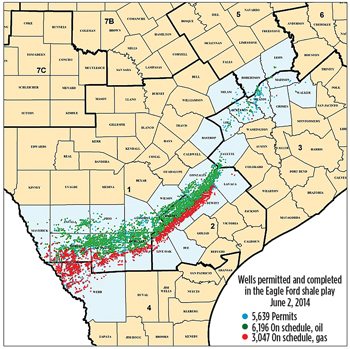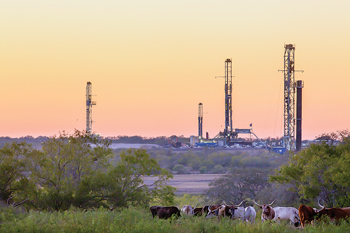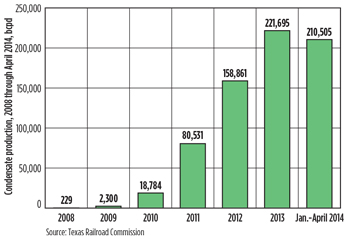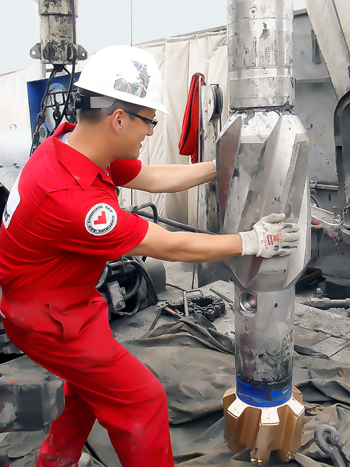 |
| An H&P Flex 3 rig drills for Statoil in Karnes County, Texas. Statoil and JV partner Talisman Energy have decided to withdraw the announced sale of their joint Eagle Ford acreage (photo by Mieko Mahi for Statoil ASA). |
|
The South Texas fairway of the Eagle Ford/Pearsall shale has taken on the feel of a more than 400-mi-long trade mart this year, as new players shell out top dollar to gain a share of what are among the highest recovery rates in the unconventional sector, and a play with plenty of room to grow.
As reflected in the cumulative $9.1 billion that Devon Energy and Encana anted up in separate acquisitions, the late-entry costs of snagging even a comparatively modest stake in this once tightly held fraternity does not come cheap. Nevertheless, they and others are more than eager to pay a hefty price as the triple-window Eagle Ford moves ever closer to the elusive 1 MMbpd oil production milestone. “This world-class asset continues to surprise to the upside,” ConocoPhillips Chairman and CEO Ryan Lance told analysts on May 14.
Underpinning the buying epidemic that has grabbed much of the attention throughout 2014, operators continue to redraw the boundaries of the more than 50-mi-wide and 400-mi-long play. As currently delineated, the Eagle Ford fairway underlies some 32 South Texas counties, stretching all the way to the state’s southernmost border, Fig. 1. Today, the eastward expansion is in full throttle, and while the play is generally linked with the underlying Pearsall shale, the trend is moving more toward exploring the co-development potential of the overlying and heavily explored Austin Chalk, and the upper and lower benches of the Eagle Ford.
 |
| Fig. 1. The latest permitting data show activity moving steadily eastward, where operators are targeting the so-called Eaglebine formation (source: Texas Railroad Commission). |
|
To the south, U.S. companies are taking a wait-and-see approach on the prospects for the swatch of the Eagle Ford that extends beyond the border. For the time being, they are content to play the waiting game until they see the final shape of Mexico’s new energy reform policy, and if any positive efforts will be made to curb the illegal drug violence that has ensnared the southern neighbor. BHP Billiton, for one, is in no hurry to line up rigs and test the feasibility of expanding its self-described “trophy asset” across the border. “We think Mexico is probably going to go slower rather than faster,” says Rod Skaufel, BHP asset president of North American Shale. “Obviously, there are some security concerns across the border, but it’s something that clearly we’re looking at.” (For an in-depth look at BHP’s Eagle Ford activity, see “Technology fueling BHP’s Eagle Ford YOY improvements”)
As it now stands, however, EOG Resources, the play’s most active operator by a wide margin, is among those most adamant that Eagle Ford will remain a robust play for some time to come. “In modeling production from the Eagle Ford, we are on a growth track for the next 10 years, before we even begin to see production level out,” Chairman and CEO Bill Thomas told analysts during the first-quarter earnings call. “Certainly the Eagle Ford is the highest rate of return play we have, and so the biggest amount of capital will go to that.”
HARDY PROGNOSIS
Thomas’ matter-of-fact projection is in line with the universal sentiment attached to the Cretaceous carbonate-rich shale, which is defined as the world-class source rock for the Austin Chalk, as well as the East Texas Woodbine field. Commonly described as an atypical shale play, the Eagle Ford, with its well-defined oil, condensate and dry gas windows, overlies the Buda Limestone and the Pearsall. The Eagle Ford proper is distinguished by an average thickness of 250 ft, although some sections are as thick as 330 ft, which contributes to what IHS Director of Equity Research Andrew Byrne concluded last year were wells that, on average, out-produce their Bakken counterparts “by a margin of two to one.”
Be that as it may, all standards of measurement suggest the heartbeat of the triple-window Eagle Ford will continue to pound at a marathoner’s rate, at least for the foreseeable future. Baker Hughes data show that as of July 14, operators had added five rigs over a week’s period, bringing the total fleet to 218 active units (Fig. 2) from the 213 drilling during the previous week. Of course, that was the same week that onshore rigs targeting oil hit a U.S. rig count record at 1,563 active units.
 |
| Fig. 2. A herd of iconic Texas longhorn steers grazes in the shadow of one of the 18 rigs Marathon is running in the Eagle Ford (photo courtesy of Marathon Oil Corp.). |
|
Historical Eagle Ford rig and well counts further attest to the efficiencies of the new-generation rigs typical of pad-dominated unconventional drilling. Last year, the mid-July rig count stood at 231, according to Baker Hughes, which documented 1,089 new wells drilled during the second quarter. Despite the comparatively smaller rig count for second-quarter 2014, Eagle Ford operators spudded 1,186 wells, up from 1,178 new wells tallied in the first quarter. Going forward, the Texas Railroad Commission (TRC), the state’s chief regulator, issued 2,659 drilling permits between January and June, compared to the 4,416 permits authorized for all of last year.
Daily Eagle Ford production, likewise, is on the upswing, according to the TRC, with reported cumulative oil production between January and April of 838,293 bpd, surpassing the 717,953-bpd average that operators churned out last year, Fig. 3. Gas production reached 3,588 MMcfd during that same period, compared to 3,779 MMcfd during 2013, TRC data show. The healthy long-term prognosis for the Eagle Ford was reinforced on June 5, when Wood Mackenzie hiked its oil production forecast, estimating that by 2020, the play would increase output 23% to 2 MMbpd.
 |
| Fig. 3. Most recent oil (left) and gas production data from the Eagle Ford. |
|
Operators, with a heavy condensate component in their production portfolio, also are cautiously cheering the U.S. Department of Commerce (DOC) decision to quietly grant export permits for distilled condensate to Pioneer Natural Resources and Houston midstream operator Enterprise Products Partners. The decision puts a crease, albeit a small one, in the 39-year-old federal ban against any oil exports, but how large a volume will eventually be shipped to international markets remains to be seen.
In a statement after the June 25 ruling, Pioneer, reportedly the Eagle Ford’s largest condensate producer, told the Dallas Morning News the decision would affect a “large portion” of its total production. The Irving, Texas-based independent, however, did not specify the volume of condensate that was mixed in with the 43,000 boed it produced in the first quarter. The latest TRC statistics show Eagle Ford operators producing 201,505 bcpd between January and April, as opposed to the 221,695 bcpd averaged in 2013, Fig. 4.
 |
| Fig. 4. Latest condensate production from the Eagle Ford. |
|
Meanwhile, the U.S. Energy Information Administration (EIA), as part of its recently released Annual Energy Outlook 2014, said a sustainability evaluation of Eagle Ford wells completed between 2008-2013 shows a mean, average, estimated ultimate recovery (EUR) of roughly 170,000 bbl/well. The EIA analysts cautioned, however, that the evaluation uncovered tremendous variability, owing largely to many wells having insufficient production history from which to draw long-term sustainability prospects. For instance, the report says EUR trends ranged from more than 300,000 bbl/well in DeWitt County to less than 25,000 bbl/well in Burleson and Maverick counties.
“Wells that are newly drilled, with fewer data points, and therefore, greater uncertainty in the fit of their decline curves, have a tendency to inflate the average EUR. Older wells, which may have been drilled and completed using technologies and practices that are no longer representative of future practices, tend to pull the average down,” the report cautioned.
Cabot Oil & Gas Chairman, President and CEO Dan Dinges, however, said in the operator’s first-quarter earnings call that “a typical well in the Eagle Ford has an EUR of approximately 500,000 boe, with a completed well cost of less than $7 million, based on approximately a 7,000-ft completed lateral.”
A YEAR OF DEALS
Devon’s $6-billion acquisition of GeoSouthern Energy on Feb. 28 took top billing in the high-dollar swap meet that drew much of the attention in the Eagle Ford this year. The purchase gave the Oklahoma City, Okla., independent 82,000 net acres in the light oil window of DeWitt and Lavaca counties. Devon, which takes over the 50-50 JV that GeoSouthern had with BHP, says it plans to invest approximately $1.1 billion to drill more than 200 wells in 2014. Its new, largely derisked property is expected to average a yield of between 70,000 and 80,000 boed. “Our Eagle Ford acquisition is one of several bold steps we have recently taken to upgrade our portfolio and improve the growth trajectory and profitability of our business,” said Devon President and CEO John Richels.
With most of the Eagle Ford core now getting well into the full-scale development mode, the Devon acquisition, analysts say, clearly illustrates the natural evolution of the shale plays, where the smaller independents dominate the exploration phase, and sell out later to deeper pockets, as their assets mature.
Following on the heels of the Devon deal, Encana Oil & Gas (USA) on June 20 officially closed its $3.1-billion acquisition of 45,500 net acres that Freeport-McMoRan controlled in Karnes, Wilson and Atascosa counties. The leasehold produced roughly 53,000 boed in first-quarter 2014 and has an estimated drilling inventory of more than 400 locations. An Encana spokesman said in late July that the newest Eagle Ford player has not yet announced its drilling plans for this year. “Gaining a position in this world-class resource play replaces the natural gas-weighted production from our Jonah and East Texas assets with higher-margin oil and NGL production,” said Encana President and CEO Doug Suttles.
Contrary to analysts’ projections and the prevailing trend, Houston’s Sanchez Energy on July 1 closed its $639-million purchase of the 106,000 acres that Shell held in Dimmit, LaSalle and Webb counties. The sale includes 176 wholly-owned producing wells, which delivered 24,000 boed in the first quarter, but with a significantly high gas component.
In other deals:
Forest Oil Corp. and closely-held Sabine Oil & Gas officially merged, with the new entity to be based in Houston. In addition to a highly prospective, 207,000-net-acre position in East Texas, the asset combination includes 65,000 net acres in the Eagle Ford. In the first quarter, Forest Oil completed six gross wells in its southern Eagle Ford leasehold with 30-day gross production rates of 418 boed. In mid-April, the operator was running two rigs in the Eagle Ford and three in its East Texas holdings.
Investment company Ares Management LP acquired San Antonio’s BlackBrush Oil & Gas for an undisclosed price, with plans to ramp up drilling in the newly acquired, 160,000-net-acre Eagle Ford leasehold.
On June 18, Panhandle Oil and Gas Inc. closed its $80.4-million purchase of a 16% interest in 1,775 net acres of oily LaSalle and Frio counties. Cheyenne Petroleum Co. will continue to serve as operator.
Sydney-based Sundance Energy Australia Ltd., on May 28, unloaded its interest in Wattenberg field of the Denver-Julesburg basin. At the same time, the company made a comparatively modest $33-million acquisition of 5,500 net acres in Dimmit County, elevating its Eagle Ford leasehold to 19,500 net acres. The seller was not identified.
Swift Energy Co., on July 15, finalized its agreement with PT Saka Energi Indonesia to jointly develop 8,300 acres in the Eagle Ford Fasken area of Webb County. Saka paid $175 million for its 36% participating interest.
On the flip side, Statoil and Talisman Energy, in May, said they were pulling their jointly held acreage off the selling block after no buyers came up with the reported $4-billion price tag they had attached to the assets. Statoil and Talisman control roughly 73,000 and 74,000 net acres, respectively, which they operate under a 50-50 JV. The partners have not disclosed any specific activity plans for the remainder of the year.
MOVE EAST CONTINUES
With Apache and Halcón Resources leading the way, the Eagle Ford continues to extend eastward, where it intersects the celebrated Woodbine formation, the source horizon for the legendary East Texas field. The so-called Eaglebine, comprising an estimated 1,000-ft thick fusion of sandstone and marine shale, described as possessing excellent porosity characteristics with not a few highly prospective source rocks, has evolved quickly as an established target within the expanding Eagle Ford network.
Apache holds an Eaglebine-high leasehold of 200,000 net (500,000 gross) acres, primarily in Brazos, Burleson and Lee Counties. As reflected in the appreciable increase in drilling permits issued over the past year, this trio represents the centerpiece of the increased prospects for the Eaglebine extension. Between January and July 20, the TRC had authorized 177 new drilling permits in the three counties, compared to 117 approved during the like period last year.
Apache began the year with five rigs in the play, and, on May 28, said its Eaglebine rig count would increase to eight by mid-year. While primarily targeting the Eagle Ford, Apache says it also is eyeing the co-development potential of the overlying Austin Chalk and the underlying Buda sandstone. Apache said its four latest wells have recorded average 30-day IP rates of just over 700 boed. The operator recently completed a 3D seismic survey over more than 300 mi2, with additional studies underway.
After unloading what it considered non-core East Texas assets, Halcón Resources now controls some 100,000 net acres prospective for the eastern Eagle Ford. In the first quarter, the independent ran four rigs, on average, to exploit El Halcón field, where production averaged 7,018 boed. In its earnings release, Halcón said much of the focal point is optimizing well spacing and completion designs to bring down development costs. “Based on results from step-out wells drilled to the south, combined with results from other offset operators, we believe our entire acreage position has been de-risked, and results are expected to be repeatable,” Halcón said in a statement.
Permian basin fixture Clayton Williams Energy controls 185,000 net acres in the Giddings area of East Texas, where it has been active since the early 1990s. While its holdings are prospective for the Austin Chalk, Eagle Ford, Buda and Georgetown formations, the independent said the Eagle Ford is the primary target for its current two-to-three-rig drilling program. With 2013 proved reserves of 15.5 MMboe, the acreage produced an average 4,734 boed in the first quarter.
Meanwhile, two-year-old Denver operator Hawkwood Energy LLC, on July 1, said it acquired East Texas acreage in two deals that, to date, have produced an aggregate 1,800 bopd. While no details were made available, Hawkwood said the combined assets it acquired separately from Crimson Energy Partners III and Encana include some 50,000 “generally contiguous” undeveloped acres spread out in Brazos, Leon, Madison and Robertson counties. “These assets establish the company as a significant player in the emerging Eagle Ford and Woodbine plays in East Texas,” Hawkwood said in a statement.
STACKING, SPACING IN VOGUE
While interest in exploring the liquids potential in the gas-prone Pearsall seems to have cooled in 2014, after undergoing a reawakening of sorts last year, most of the co-development prospects now focus on the overlying Austin Chalk. Marathon, for instance, is conducting two pilots in Karnes County, aimed at exploring the co-development potential of the Upper Eagle Ford and Lower Austin Chalk.
Marathon said during its year-end 2013 analysts day that stacking, tighter spacing of 40-to-60 acres, and improved completion efficiency combine to increase its potential Eagle Ford resource base by an incremental 1.5 BBoe. The operator said that wells completed last year with the tighter spacing have exhibited higher IP than offsets completed at 80-to-160-acre spacing. Meanwhile, like all the unconventional plays, operators in the Eagle Ford continue to tighten well spacing to further augment their leaseholds and increase overall recoveries. In 2010, EOG Resources thought it would be viable to drill about five wells/section on a 130-acre spacing scenario. Fast forward, and the major player has plans to drill up to 16 wells/section on 50-acre spacing, which it believes will deliver higher EUR of around 320,000 boe.
“The Eagle Ford continues to demonstrate improvements in well productivity from ongoing refinements and completion techniques,” said Thomas. “A number of recent Eagle Ford wells have IP rates in excess of 4,000 boed. The Eagle Ford continues to be our largest growth asset, with the highest after-tax rates of return.”
Marathon points out that contributing to the improved rates are zipper stimulations from pads “materially impacting complexity and improving recovery,” as well as the evolution of fluids, volumes, rates, cluster spacing and proppant loading, as spacing tightens.
ROBUST ACTIVITY AHEAD
Wood Mackenzie analysts estimate that $27 billion will be invested in the Eagle Ford this year to drill roughly 3,000 wells—an expenditure that it says will exceed the annual revenue of Bolivia. Judging from a small sampling of the firmly entrenched players, most of which are planning double-digit rig counts this year, that estimate could prove conservative.
EOG Resources holds a commanding 632,000-net-acre position, of which 564,000 net acres underlie the prolific oil window. The play’s largest oil producer said its first-quarter production jumped 62% year-over-year, pumping out 207 Mboed, net, as of March 31. Six more recent wells delivered IP rates averaging 3,503 bopd, the operator said.
The Houston-based independent plans an aggressive 2014 drilling program, with 26 rigs scheduled to drill an estimated 520 net wells. EOG, which says it is continuing to investigate various completion techniques to improve production, has managed to reduce its average completed well costs to roughly $5.5 million from a 2011 average of $7.2 million. EOG expects its premier acreage position to be held by production (HBP) by mid-year, which it says will add more flexibility to the drilling program.
Anadarko Petroleum plans to operate 10 rigs (Fig. 5) and drill an estimated 400 wells on the 185,000 net (388,000 gross) acres it controls, primarily in liquids-rich Dimmit, LaSalle, Maverick and Webb counties. The Woodlands, Texas-based operator said it has identified more than 2,500 prospective wellsites yet to be drilled. To date, Anadarko said it has constructed more than 1,000 Eagle Ford wells, averaging one new well/day being connected to the sales line. Production, across-the-board, increased year-over-year in the first quarter, averaging 59,000 boed, up 41% from the prior first quarter. Of that, total liquids sales volume reached 40,600 bpd. In its first-quarter earnings report, Anadarko said its 10 rigs drilled 102 wells in an average of 8.1 days, with 110 new wells hooked up to production.
 |
| Fig. 5. One of the 10 rigs drilling for Anadarko in the Eagle Ford (photo courtesy of Anadarko Petroleum Corp). |
|
ConocoPhillips plans to operate a 12-rig drilling program this year and has pinpointed more than 3,000 potential wellsites in its estimated 227,000 net acres, though it has not released how many sites will be drilled in 2014. After the independent exited the first quarter at 16,000 bopd, CEO Lance told investors that the operator projects a ramp-up in production to 250,000 bopd by 2017. “Last year, at this point in time, we were talking about ramping up to 150,000 bopd,” Lance said. “So, that’s a pretty substantial increase from what we are seeing from the pilot and gives us confidence to move forward on the development of the field.”
Marathon Oil Corp. has allocated a capital expenditure of $2.3 billion in the Eagle Ford this year, which will include 18 rigs and the drilling of between 250-260 net (385–405 gross) wells. Within its 204,000-net-acre-position, Marathon, which forecasts production this year to approach 120,000 boed, said its first co-developed Austin Chalk well recorded a 30-day IP rate of 1,600 boed in the first quarter.
Pioneer Natural Resources and its minority partner, India’s Reliance Industries, plan to drill 110 liquids-rich wells this year, of which 45 are planned for completion in the Upper Eagle Ford as part of its continuing downspacing and staggered drilling program. A cumulative 34 wells were drilled in the first quarter within the estimated 212,000-net-acre leasehold with 32 of the wells placed on production. The partners have earmarked a $545-million capital expenditure for the Eagle Ford this year.
SM Energy, which holds 144,000 net acres, recorded 20 flowing completions in the first quarter, and expected its drilling and completion carry with Japan’s Mitsui to be exhausted by the second quarter. The independent has not released how many wells it expects to drill this year, but said lateral lengths of those drilled in the first quarter increased by roughly 25% from the 2013 average. Net production in the first quarter rose to 76.3 Mboed from the 74.8 Mboed in fourth-quarter of 2013.
Cabot Oil & Gas plans to add a third rig to its Eagle Ford fleet in the third quarter to meet its planned 40-to-50-net-well 2014 drilling program. The operator recently added 4,000 net acres, bringing its total Eagle Ford holdings to 66,000 net acres, of which an estimated 60% is HBP. Cabot says 50% of its program this year will be from pads of four wells or greater. Its six-well pad in Atascosa County has recorded an average IP rate of 1,045 boed, with a sustained 25-day rate of 946 boed/well.
In early April, Cabot completed its first six-well pad in Frio County, with the wells averaging a completed lateral link of about 6,700 ft and an average 25 stages. The wells individually achieved an average peak, 24-hr IP rate of 1,045 boed with an 89% oil cut. Cabot says the pad drilling efficiencies saved some $600,000/well.
Penn Virginia Corp., based in Radnor, Pa., recorded first-quarter production of 14.8 Mboed and closed 2013 with proved liquid-heavy reserves of 75.6 MMboe within its 80,000-net Eagle Ford leasehold. The independent says it is looking at increasing its net acreage position to 100,000 acres. Penn Virginia is running six rigs, with a seventh to be added by the third quarter, the company said, with plans to drill 64.7 net (117 gross) wells this year.
Rosetta Resources plans to run four to five rigs this year to drill and complete between 90–95 gross wells on its 63,000-net-acre holding. The Houston independent delivered 50 Mboed net production in the first quarter, keeping it in line with its plans to increase year-over-year production by 20%–30% over 2013. Rosetta, which is continuing its testing of Eagle Ford benches, said that excluding the Upper Eagle Ford and the fully developed Karnes Trough properties, it had completed 218 wells as of March 31 and with an additional 57 awaiting completion. 
DRILL MULTIPLE SECTIONS IN A SINGLE RUN
 |
| Fig. 1. In a series of four wells on a pad location, curve and lateral sections were drilled in a single trip using the RSS assembly (photo courtesy of Weatherford). |
|
In shale plays, such as the Eagle Ford, rotary steerable systems (RSS) are being used to drill multiple wellbore sections—vertical, curve and lateral, or curve and lateral—without tripping the bottomhole assembly (BHA). This approach to wellbore construction is having a significant impact on reducing cost and improving the ability to develop unconventional assets.
Weatherford has used its Revolution RSS system in the U.S. shale plays, in more than 200 runs of greater than 7,000 ft and more than 40 runs greater than 10,000 ft. The longest single-run well, to date, is 14,450 ft, and longer runs are possible. The system is used routinely to execute curves of 10°/100 ft of build-up rate (BUR).
Single-run solution. Drilling two or three sections of the well in one run presents multiple challenges: the vertical section must maintain a high degree of verticality; the curve must be smooth with a BUR up to 10°/100 ft; the lateral section must maintain the selected inclination and may require geosteering. These results must be applied to simple 2D J-type wells to complex 3D geometries. Weatherford uses a single BHA for all directional requirements, and point-the-bit RSS technology to maximize bit life, achieve low borehole tortuosity, and enhance borehole quality.
The Revolution RSS point-the-bit system works by producing a controllable steering tilt angle through a biasing unit that points the bit in the desired direction, using a specially profiled stabilizer as a fulcrum.
Proportional control continuously controls bit tilt, which enables the drilling of a smooth, consistent hole curvature. The control avoids cycling the steering mechanism on and off to produce the required dogleg severity. For example, if a 5°/100 ft build rate is desired, the RSS is set for 5°/100 ft, rather than building at 10°/100 ft for half the time and drilling straight for the other half (or some other mark/space ratio).
Automatic drilling modes are used to assist the operation and are particularly useful when drilling the vertical and horizontal sections. These modes—seek vertical, hold inclination (lateral/tangent), and autopilot (for 2D and 3D directional control)—save time by removing the need to constantly communicate to the RSS. The closed loop control system continuously monitors sensors and makes decisions to keep the wellbore on track.
Drilling hazard mitigation is addressed in a holistic approach to the BHA design that considers bit selection, LWD, and power section options to optimize the assembly for the application. As with all rotary steerable systems, continuous rotation of the drillstring enhances hole cleaning, which clearly reduces the risks of getting stuck. Similarly, near-bit directional measurements are continuously monitored to reduce the risks of not meeting the well placement requirements.
Eagle Ford applications. In a series of four wells on a pad location, curve and lateral sections were drilled in a single trip using the RSS assembly. Importantly, dogleg severity and tortuosity in the lateral section were minimized to improve casing running and logging. Drilling operations were faster in all four wells, with one drilled 43% quicker than estimated to save 7.5 days of drilling time. In each of the wells, the drilling path closely matched the planned well path. The wells were drilled uneventfully, and casing was successfully run to TD with no issues.
The system drilled an 8½-in. hole from the kickoff point to TD, building an 8° curve and continuing the lateral section to an average MD of 17,300 ft. Rate of penetration in the long lateral section, where motor systems typically have trouble, averaged 104 ft/hr. While drilling, the RSS and HEL LWD system continuously monitored downhole vibrations, including stick-slip, whirl, and lateral and axial torsional dynamics. The information was used to adjust drilling parameters to optimize performance in difficult sections of the Austin Chalk and Anacacho formations directly overlying the Eagle Ford.
In another Eagle Ford application, the RSS was used to drill all three sections of an extended 2D J-type well in a single run of nearly 12,000 ft.
The ROP was 75% faster than conventional steerable motor assemblies and resulted in the fastest well drilled in the Eagle Ford shale. The well was completed seven days ahead of plan, saving the operator approximately $700,000. 
|
|










